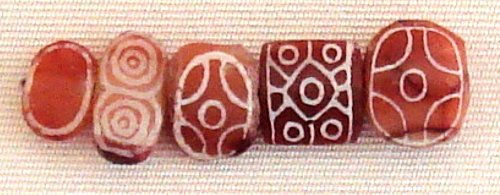Carnelian - Sunny Gems of the Ancient World
- Sylvia Rose

- Dec 15, 2023
- 3 min read
Updated: Feb 25, 2025
Carnelian (early: cornelean) is already used in the Stone Age to make beads. Pebbles of the reddish orange gemstone might be polished by nature in rivers. With bow drills, people make holes in the beads. Carnelian is chalcedony, with a chemical structure SiO2 (silicon dioxide)

Carnelian appears in the Wadjet crown worn by Egyptian royal women. With its inner glow, the stone is greatly esteemed by Egyptians as it holds the power of the Sun and the warmth of the soul. This is what ancient merchants are selling, and well they know their markets.
The Egyptian scarab is a widespread symbol of protection. The dungball it rolls equates to the sun, because it fertilizes the land as it buries these balls. Scarab amulets and decorations are made of gems such as carnelian or unique Egyptian blue faience.

The red-orange stone is popular for making wax seals, as wax doesn't stick to carnelian. In some cultures the stone is considered to have inner fire and to deflect negative or unwanted energy. In the ancient world magic is part of everyday life.
Associated with sun gods Ra or Atum in Egypt, and other deities throughout the world, carnelian is a stone of rulers and elites, but also of the people. Use of carnelian in jewelry, talismans and tools is not determined by class. Anyone can buy and wear this beautiful gem.

Amulets of carnelian are found within the wrappings of mummified corpses. A carnelian mine in south Egypt is producing in ancient times. Carnelian is an important trade item along with other gemstones such as turquoise, amber and lapis lazuli.
The inner glow is created in carnelian by inclusions of hematite, a red iron oxide lending its hue to jewels and rocks and potters' clay. It's said the ram-headed god Khnum, or Banebdjedet in Mendes, creates humans of clay on his potter's wheel.

A type of chalcedony, carnelian gets its color from iron oxide inclusions. The stone color can range from opaque to translucent and pale orange yellow to deep red and is often valued for its color gradation. With a Mohs hardness of 6.5 - 7 it's a good carving stone.
A similar stone, sard, may be used interchangeably with carnelian. It's harder, more opaque and with brown-red tones. Sard is often the choice of the ancients for making stamp, ring and cylinder seals due its resistance to wear.

Beads of carnelian have been found in Greece from a Neolithic source, indicating early trade. Later, carnelian trends during the Greco-Roman era.
In crystal healing the gem carnelian connects with the lower chakras. It relates to stability, grounding, creativity and self-confidence. Carnelian forms in igneous, metamorphic and sedimentary rocks. Basalt stone harbors the largest carnelian gems, with the purest reds.
Carnelian is a semi-precious stone today, but in ancient times this striking rock is among the most valued of gems. It's often found in grave burials and in the tombs of Egyptian pharaohs such as Tutankhamun.
The ancient Egyptians may have had more local sources but only one mine is mentioned. In the metal ages BCE, India is a major supplier of carnelian. Another producer is the Arabian Peninsula, to the northeast and southeast.
Not all mines of ancient times are still operating. Today, producers of carnelian include Yanacodo (Peru); Ratnapura (Sri Lanka); and Thailand. Carnelian has been found in Indonesia, Brazil, India, Russia (Siberia), and Germany.
Non-Fiction Books:
Fiction Books:
READ: Lora Ley Adventures - Germanic Mythology Fiction Series
READ: Reiker For Hire - Victorian Detective Murder Mysteries




